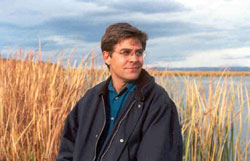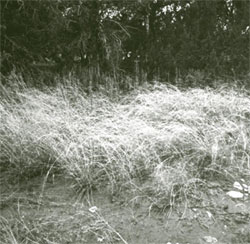Sound Art
Air Date: Week of July 12, 2002
Doves cooing, juniper branches crackling, wind blowing through the holes of a dead cactus. These are some of the sounds that artist Steve Peters recorded at an outdoor art space in New Mexico. Peters transformed the sound into an installation called "Hear-ings." Paul Ingles produced our story.
Transcript
CURWOOD: Listening to nature can be an art form. At least it is for sound artist Steve Peters. He spent hours recording in an outdoor space in New Mexico called "The Land," taking care to capture sounds of nature that normally escape our attention.
Steve Peters has turned his recordings into a piece that recreates the soundscape of the land in a museum setting. He talked with producer Paul Ingles about the production of "Hear-ings.".
[BIRD SOUNDS UNDER]
PETERS: The land is located about an hour and a half drive southeast of Albuquerque, New Mexico in the eastern foothills of the Monzano Mountains. It's a 40-acre site. But there's 14 acres of it that they use as a work site and exhibition space for environmental art and, specifically, low-impact environmental art.
[DOVES COOING]
PETERS: I was just so impressed by how still it was and quiet. And what happened was that, because it was so quiet, every little sound that happened really stood out. You really noticed it. And all of the sounds had this kind of delicate, hushed quality that I'm a real sucker for anyway.
So, what happens, if I commit myself to coming here for a year, a couple of times a month, and sitting and doing nothing more for an hour at a time than listening to what's going on here?

Sound artist Steve Peters (Photo: Mary Roy)
[JUNIPER BRANCHES MOVING]
PETERS: Each time I would go and spend this time listening to this place, I would make a recording of that hour. I stretched a whole day out over a year. I made 24 hour cycle of recordings over the course of one year. What I did with all those 24 hours of recordings was to edit each hour down to about five minutes or so.
[TRAIN SOUND, THEN GRASSHOPPERS, THEN WIND BLOWING THROUGH CACTUS]
PETERS: This is the sound of a chollo cactus. Chollo cactuses are these kind of long, spindly things. And when they die, they leave these beautiful kind of sculptural shapes, like long tubes with little long holes in them, and they're hollow. So this is a chollo cactus with a contact microphone attached to it on a windy day. And you're hearing the wind sort of whistling through the holes in this dead cactus.
[WIND THROUGH CACTUS, THEN TO SCREECHING SOUND]
PETERS: This here was probably the most sensational sound in the whole show. I had set a contact microphone outside the entrance to an anthill of these large, red, I think, harvesting ants. And, a couple of scouts came out and investigated, and they walked around on it. And then they went back and got a whole bunch more ants. And they all came out and swarmed on the contact microphone and started chewing on it. And then they started making these sounds, which I later learned are called "strigulation" where they sort of have like a rub board on their thorax and their abdomen or something. And they rub it together and make this little shrieking noise. It was slightly terrifying. I thought, "Okay. I think I better go now."
[ANTS SHREIKING, THEN TO THUNDERSTORM, THEN TO GRASS BLOWING AGAINST WIRE FENCE]

(Photo: © Margot Geist)
PETERS: This is the sound of a wire fence that runs around the perimeter of the property. And that's kind of an interesting story because I thought this fence was such an insult to the landscape in a way. I'd sit there and go, "You know, the land on this side of it isn't any different than the land on the other side. And what's this thing doing here. It's just ugly and stupid."
And then one day, I was out there, and it was really windy. And I put my ear up to one of the fence posts, and it was the most beautiful sound. [FENCE SOUNDS] The wind was blowing these stocks of grass against the lower strand of the wire fence.
[BIRD CAWS AND OTHERS]
PETERS: You don't get a sense of the beauty of the place from a quick scan. You really have to slow down and be with it and accept it on its own terms. And I think that's a really good lesson for all of us to carry over to all sorts of other areas in our lives.
[MUSIC UP AND UNDER: LITHOPS, "UNI UMIT #4," UNI UMIT, MOIKAI, 1997]
CURWOOD: Steve Peters' sound art exhibit "Hear-ings" is now at the Magnifico Art Space in Albuquerque, New Mexico. Our story was produced by Paul Ingles.
Links
HEAR-INGS: A Sonic Geohistory (book/CD La Alameda Press)
!Magnífico¡ Arts Incorportated presents: being, here: work from the land works by Steve Peters
">
!Magnífico¡ Arts Incorportated presents: being, here: work from the land works by Steve Peters ">
Living on Earth wants to hear from you!
Living on Earth
62 Calef Highway, Suite 212
Lee, NH 03861
Telephone: 617-287-4121
E-mail: comments@loe.org
Newsletter [Click here]
Donate to Living on Earth!
Living on Earth is an independent media program and relies entirely on contributions from listeners and institutions supporting public service. Please donate now to preserve an independent environmental voice.
NewsletterLiving on Earth offers a weekly delivery of the show's rundown to your mailbox. Sign up for our newsletter today!
 Sailors For The Sea: Be the change you want to sea.
Sailors For The Sea: Be the change you want to sea.
 The Grantham Foundation for the Protection of the Environment: Committed to protecting and improving the health of the global environment.
The Grantham Foundation for the Protection of the Environment: Committed to protecting and improving the health of the global environment.
 Contribute to Living on Earth and receive, as our gift to you, an archival print of one of Mark Seth Lender's extraordinary wildlife photographs. Follow the link to see Mark's current collection of photographs.
Contribute to Living on Earth and receive, as our gift to you, an archival print of one of Mark Seth Lender's extraordinary wildlife photographs. Follow the link to see Mark's current collection of photographs.
 Buy a signed copy of Mark Seth Lender's book Smeagull the Seagull & support Living on Earth
Buy a signed copy of Mark Seth Lender's book Smeagull the Seagull & support Living on Earth

